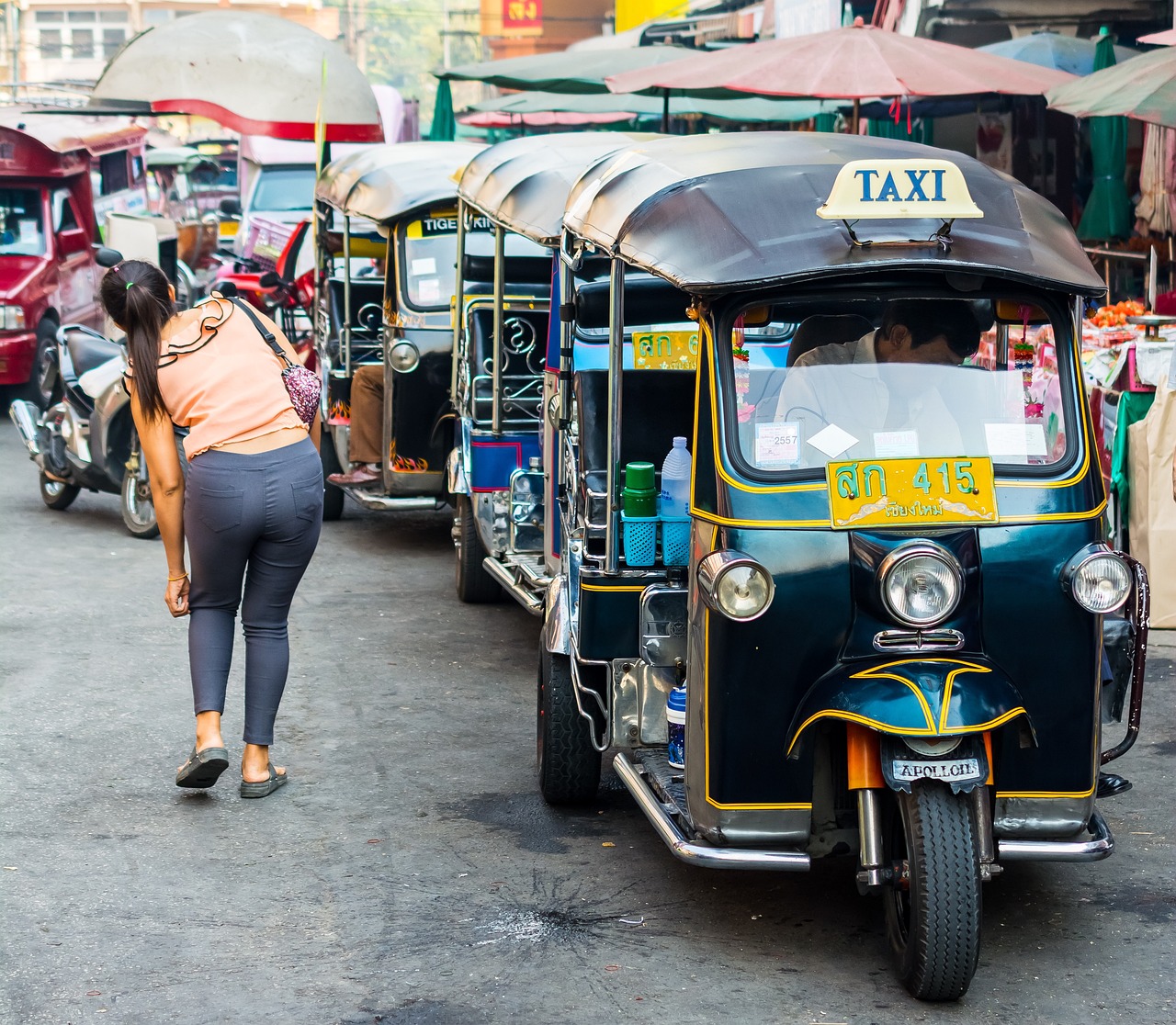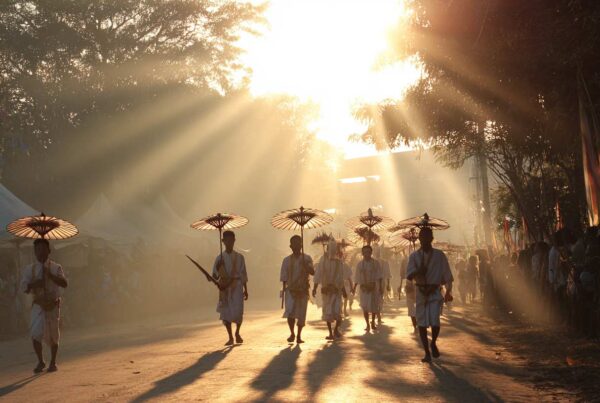Chiang Mai’s charm is best discovered at street level. From temple mornings to night market evenings, the city’s rhythm unfolds in short rides and slow journeys rather than long commutes. Getting around here is straightforward once you understand the local transport options. Whether you are exploring the Old City’s narrow lanes or heading out to the mountains for a day trip, Chiang Mai offers many practical ways to move from A to B.
Shared public red trucks to private transfers included in organized tours, this guide covers the main transport modes, how to use them, and what to expect.
Transport and Crowds
Roads near Tha Phae Gate and the river can close or slow during peak hours. The most reliable approach is to walk between the Old City and the river. If you are staying farther away, use a songthaew or rideshare to reach a drop-off point before entering pedestrian areas. At the end of the night, expect queues. A calm walk back through quieter streets is often faster and more pleasant.
Getting Around the Old City
The Old City of Chiang Mai is compact and walkable. Its square moat measures less than two kilometers on each side, making most points accessible on foot or by a short ride. The inner streets are lined with temples, cafés, and small guesthouses, while the outer ring connects to major roads leading toward Nimman, the Night Bazaar, and the Ping River.
Many visitors begin by walking, especially in the morning or late afternoon when the light softens and the air cools. Sidewalks can be narrow or uneven, but traffic moves slowly. You will find drink stalls, 7-Elevens, and shaded rest spots almost everywhere. Still, for longer distances or when the heat builds, transport options quickly become useful.

ℹ️
This mix keeps your day balanced: Walking when cool, riding when hot, and letting local transport carry you where it shines.
Songthaews: The Red Shared Trucks
Songthaews (pronounced “song-tows”) are Chiang Mai’s most distinctive local transport. The name means “two benches,” referring to the seats in the back of these modified red pickup trucks. They operate as a mix between bus and taxi (flexible, inexpensive, and constantly on the move).
To catch one, simply flag a passing red truck from the roadside. Tell the driver your destination, and if it matches their route, they will nod and you can hop in. Fares inside the city usually range within a small, standard amount. If the driver quotes more, it may mean your route lies outside the city center or you want private use of the vehicle. Payment is done directly to the driver when you get off.
Songthaews are ideal for short hops between the Old City, Nimman, and the Night Bazaar. For nearby attractions such as Wat Umong or Doi Suthep, you can hire one privately. Negotiating the fare in advance is normal, drivers are generally friendly and used to visitors. Carry small bills, as change for large notes is rare.
ℹ️
Inside Tips for Riding Songthaews
- Negotiate when private: For shared rides inside the Old City, the price is fixed and very low. But if you want to rent the whole vehicle for yourself (for temple runs or mountain trips), polite negotiation is expected. You can usually agree on a rate about 20–30% below the first quote if you smile and stay friendly.
- Confirm direction: Most drivers circle popular routes, but some head to suburban districts. Always show your destination on your phone map to avoid confusion.
- Pay at the end: Hand the driver your fare only when you step off. Locals often press the buzzer button in the back to signal their stop.
- Quiet courtesy: Avoid loud calls or eating inside. It’s considered polite to leave the small rear door closed softly when getting out.
- Best times: Red trucks run all day, but are easiest to flag down between 7 am – 9 pm. At night, expect slightly higher prices or fewer shared routes.
Tuk Tuks: The Classic Three-Wheelers
Next to the red trucks, the tuk tuk remains an iconic way to experience Thai street life. These three-wheeled motor taxis buzz around with a familiar growl, offering direct rides for short to medium distances. Fares are higher than songthaews but they provide privacy and speed. Tuk tuks are most common near markets, major intersections, and the Old City gates.
As most are independently operated, there are no meters. Simply state your destination and agree on a price before setting off. Short rides within central areas stay affordable; longer trips or late-night rides cost a bit more. For two passengers, tuk tuks are comfortable enough, and many drivers decorate their vehicles with personal flair . LED strips, mirrors, or bright stickers, the ride is breezy and open, so hold onto your bag and enjoy the city at eye level.
ℹ️
Inside Tips for Taking Tuk Tuks
- Agree clearly before boarding: Say your destination and confirm the price for the ride, not per person. Short city rides are inexpensive, but for longer distances, a little negotiation is normal.
- Polite bargaining: Smile and offer about 10–20% less than the initial quote. Drivers appreciate friendly conversation more than hard haggling.
- Nighttime rides: Fares go up slightly after dark or during rain — this is expected and not overcharging.
- Keep belongings secure: The open design means wind and space are limited. Keep small bags on your lap and phones zipped away when taking photos at speed.
- Find official stands: Around Tha Phae Gate, Chiang Mai Gate, and the Night Bazaar you’ll see tuk tuk queues with fixed starting prices — these are good reference points.
Rideshare and App Transport
Chiang Mai’s rideshare scene is well developed. Grab (the Southeast Asian equivalent of Uber) is widely used for car and motorbike rides. Pricing is transparent through the app, and cashless payment is possible. It’s convenient for airport pickups, evening returns, or travel outside the central area when you prefer a door-to-door ride.
Other local apps occasionally appear, but Grab remains the most reliable. Car drivers are polite, usually speak enough English for basic communication, and know popular locations well. During festivals or rainy nights, waiting times can increase, so booking in advance helps. For groups, Grab’s multi-seat car options are a comfortable alternative to taxis.
Scooters and Motorbikes
For those staying longer or eager to explore independently, renting a scooter can be very convenient. Chiang Mai’s roads are generally manageable, and most rental shops provide automatic 110-125cc scooters, helmets, and optional insurance. Daily and monthly rates are reasonable. Bring your passport, driving license, and a small cash deposit or copy for paperwork.
Before renting, check that the scooter is in good condition, functioning lights, brakes, mirrors, and horn. Always wear a helmet, even on short rides. Locals value safe and courteous driving. Remember that Thailand drives on the left, and traffic circles around the Old City can be busy during rush hours. Stay within your comfort zone, ride defensively, and avoid peak intersections if you’re new to the area.
Local Tips for Confident Riders
- Learn the rhythm: traffic flows smoothly once you match its pace: slow, steady, and predictable.
- Be visible: use lights at dusk and avoid wearing dark clothing at night.
- Know the main routes: the moat road (Rachadamnoen and its ring) circles the Old City clockwise on one side, counterclockwise on the other.
- Carry a digital copy of your passport and international license when riding outside the city.
- Stay informed: some areas occasionally host roadside checks for documentation and helmet use, so keep everything ready and ride responsibly.
Many travelers appreciate a short introduction from locals before setting off. Stay in CNX can connect guests with trusted partners who offer scooter orientation sessions and route planning advice. This way, you can explore with confidence, knowing what to expect on different roads and at various times of day.
Private Transfers and Tour Transport
Sometimes convenience matters more than adventure. When joining tours or day trips through Stay in CNX, transport is included automatically. Travelers are picked up directly from their accommodation (hotel, guesthouse, condo, or Airbnb) and returned after the experience. This door-to-door approach removes the stress of arranging taxis or navigating early-morning pickup points.
Vehicles used for tours are clean, air-conditioned, and driven by professionals familiar with the region’s roads. For trips to Doi Inthanon, Chiang Dao, or rural craft villages, this service saves time and ensures you reach each stop safely. Most guests find the included transfer as valuable as the tour itself, especially after a long day outdoors.
ℹ️
Inside Tips for Private Transfers and Tours
- Hotel pickup included: Stay in CNX tours always include pickup and drop-off from your accommodation, whether it’s a hotel, condo, or Airbnb. You simply wait at your lobby or gate at the arranged time.
- Plan buffer time: Chiang Mai traffic is gentle but can slow near markets. Allow a short cushion before scheduled tours or airport departures.
- Ask about local shortcuts: Drivers know alternative scenic routes that bypass busier sections, a good way to see countryside views without extra time.
- Pack light: Most tour vehicles have space for small daypacks; bulky luggage is better kept at your stay.
- Share preferences: If you prefer photo stops or quieter routes, mention it politely: Local drivers often adjust plans to match guest comfort.
Bicycles and E-Bikes
Within the Old City, bicycles remain a pleasant option. Some hotels and cafés rent them by the hour or day. Flat terrain and compact distances make cycling enjoyable in early mornings before traffic thickens. Helmets are not always provided, so bringing or renting one separately is wise. Increasingly, eco-tour companies also offer guided e-bike tours that cover city temples and surrounding countryside with minimal effort.
Walking and Exploring on Foot
Do not underestimate walking as a mode of discovery. The slow pace reveals details you might otherwise miss a quiet shrine, an old wooden house, a street-side noodle shop. Chiang Mai’s center is safe for pedestrians, though crossing multi-lane roads requires patience. Use marked crosswalks when available and make eye contact with drivers before stepping out. Comfortable sandals or sneakers are essential, especially if you plan to wander from temple to café to market.
Recommended Daily Plan for Easy Movement
- Morning: Walk or cycle within the Old City, visiting temples and cafés.
- Midday: Take a songthaew or Grab to lunch spots or workshops in Nimman or along the Ping River.
- Afternoon: Relax at a café, then use a short tuk tuk ride back toward your accommodation.
- Evening: Head out again with a rideshare to the night market or join a tour with included pickup.
✨ Explore Chiang Mai With Local Comfort
✔️ Pickup and drop-off directly from your hotel, condo, or Airbnb
✔️ Small groups and professional local drivers
✔️ Carefully timed routes to avoid heavy crowds
✔️ Local insight into hidden viewpoints and authentic stops
Key Takeaways
📋
- Use songthaews for short rides and flexible routes.
- Tuk tuks offer private, quick rides for couples or small groups.
- Grab is ideal for longer distances and airport runs.
- Scooters provide freedom; ride prepared and informed.
- Tours booked with Stay in CNX include door-to-door transport and local guidance.
Helpful planning resources
Final Notes
Getting around Chiang Mai is simple once you know your options. The city’s size and pace make every mode of travel practical, each suited to a different moment of your stay. Whether you prefer the lively backseat of a songthaew, the breeze of a tuk tuk ride, or the independence of a scooter, movement becomes part of the experience. For day trips beyond the city, joining a tour with organized transport ensures comfort and reliability. With these choices at hand, exploring Chiang Mai becomes as enjoyable as the destinations themselves.



